Anomalous Coronary Arteries and the Risk of Adverse Cardiac Events
Abstract
Background
Anomalous coronary arteries and the risk of adverse cardiac events
Imaging modalities in the assessment of coronary artery anomalies
Therapeutic options in individuals with coronary artery anomalies
Conclusions and key messages
- Increased use of noninvasive imaging results in increasing absolute numbers of patients detected with ACAOS
- In middle-aged individuals with newly diagnosed ACAOS, outcome is not statistically different from that of a matched control cohort without anomalies
- Hybrid CCTA/SPECT discriminates the impact of ACAOS from concomitant CAD on myocardial ischaemia/scarring. Impairment of myocardial perfusion due to ACAOS per se seems to be exceedingly rare and such impairment is much more likely attributable to concomitant CAD.
- In patients with ACAOS, any presumed prognostic benefits from surgical repair and sports restriction should be individually carefully balanced against the risk of a surgery and possible impairment of quality of life
- Decisions about patient management should be made after considering all available information, such as symptoms, age, sports behaviour, and imaging of high-risk anatomical features and possible haemodynamic consequences
- More evidence based on prospective trials and multicentre registries with follow-up studies is imperatively needed to modify current recommendations.
Funding / potential competing interests
Abbreviations
| ACAOS: | anomalous origin of the coronary artery from the opposite sinus of Valsalva |
| CAD: | coronary artery disease |
| CCTA: | coronary computed tomography angiography |
| CMR: | cardiac magnetic resonance imaging |
| PET: | positron emission tomography |
| SCD: | sudden cardiac death |
| SPECT: | single photon emission computed tomography |
References
- Angelini, P. Coronary artery anomalies: an entity in search of an identity. Circulation 2007, 115, 1296–1305. [Google Scholar] [CrossRef]
- Gräni, C.; Benz, D.C.; Schmied, C.; Vontobel, J.; Possner, M.; Clerc, O.F.; et al. Prevalence and characteristics of coronary artery anomalies detected by coronary computed tomography angiography in 5634 consecutive patients in a single centre in Switzerland. Swiss Med Wkly 2016, 146, w14294. [Google Scholar] [CrossRef] [PubMed]
- Cheezum, M.K.; Ghoshhajra, B.; Bittencourt, M.S.; Hulten, E.A.; Bhatt, A.; Mousavi, N.; et al. Anomalous origin of the coronary artery arising from the opposite sinus: prevalence and outcomes in patients undergoing coronary CTA. Eur Heart J Cardiovasc Imaging 2017, 18, 224–235. [Google Scholar] [CrossRef] [PubMed]
- Clark, R.A.; Marler, A.T.; Lin, C.K.; McDonough, R.J.; Prentice, R.L.; Malik, J.A.; et al. A review of anomalous origination of a coronary artery from an opposite sinus of Valsalva (ACAOS) impact on major adverse cardiovascular events based on coronary computerized tomography angiography: a 6-year single center review. Ther Adv Cardiovasc Dis 2014, 8, 237–241. [Google Scholar] [CrossRef]
- Maron, B.J.; Haas, T.S.; Ahluwalia, A.; Murphy, C.J.; Garberich, R.F. Demographics and Epidemiology of Sudden Deaths in Young Competitive Athletes: From the United States National Registry. Am J Med 2016, 129, 1170–1177. [Google Scholar] [CrossRef]
- Ghadri, J.R.; Kazakauskaite, E.; Braunschweig, S.; Burger, I.A.; Frank, M.; Fiechter, M.; et al. Congenital coronary anomalies detected by coronary computed tomography compared to invasive coronary angiography. BMC Cardiovasc Disord 2014, 14, 81. [Google Scholar] [CrossRef]
- Gräni, C.; Buechel, R.R.; Kaufmann, P.A.; Kwong, R.Y. Multimodality Imaging in Individuals With Anomalous Coronary Arteries. JACC Cardiovasc Imaging 2017, 10, 471–481. [Google Scholar] [CrossRef] [PubMed]
- Yamanaka, O.; Hobbs, R.E. Coronary artery anomalies in 126,595 patients undergoing coronary arteriography. Cathet Cardiovasc Diagn 1990, 21, 28–40. [Google Scholar] [CrossRef]
- Lorenz, E.C.; Mookadam, F.; Mookadam, M.; Moustafa, S.; Zehr, K.J. A systematic overview of anomalous coronary anatomy and an examination of the association with sudden cardiac death. Rev Cardiovasc Med 2006, 7, 205–213. [Google Scholar]
- Maron, B.J.; Shirani, J.; Poliac, L.C.; Mathenge, R.; Roberts, W.C.; Mueller, F.O. Sudden death in young competitive athletes. Clinical, demographic, and pathological profiles. JAMA 1996, 276, 199–204. [Google Scholar] [CrossRef]
- Eckart, R.E.; Scoville, S.L.; Campbell, C.L.; Shry, E.A.; Stajduhar, K.C.; Potter, R.N.; et al. Sudden death in young adults: a 25-year review of autopsies in military recruits. Ann Intern Med 2004, 141, 829–834. [Google Scholar] [CrossRef]
- Jo, Y.; Uranaka, Y.; Iwaki, H.; Matsumoto, J.; Koura, T.; Negishi, K. Sudden cardiac arrest: associated with anomalous origin of the right coronary artery from the leh main coronary artery. Tex Heart Inst J 2011, 38, 539–543. [Google Scholar]
- Gräni, C.; Chappex, N.; Fracasso, T.; Vital, C.; Kellerhals, C.; Schmied, C.; et al. Sports-related sudden cardiac death in Switzerland classified by static and dynamic components of exercise. Eur J Prev Cardiol 2016, 23, 1228–1236. [Google Scholar] [CrossRef]
- Gräni, C.; Benz, D.C.; Steffen, D.A.; Clerc, O.F.; Schmied, C.; Possner, M.; et al. Outcome in middle-aged individuals with anomalous origin of the coronary artery from the opposite sinus: a matched cohort study. Eur Heart J. 2017, 38, 2009–2016. [Google Scholar] [CrossRef]
- Gräni, C.; Benz, D.C.; Schmied, C.; Vontobel, J.; Mikulicic, F.; Possner, M.; et al. Hybrid CCTA/SPECT myocardial perfusion imaging findings in patients with anomalous origin of coronary arteries from the opposite sinus and suspected concomitant coronary artery disease. J Nucl Cardiol 2017, 24, 226–234. [Google Scholar] [CrossRef]
- Benz, D.C.; Gräni, C.; Hirt Moch, B.; Mikulicic, F.; Vontobel, J.; Fuchs, T.A.; et al. Minimized Radiation and Contrast Agent Exposure for Coronary Computed Tomography Angiography: First Clinical Experience on a Latest Generation 256-slice Scanner. Acad Radiol 2016, 23, 1008–1014. [Google Scholar] [CrossRef]
- Ripley, D.P.; Saha, A.; Teis, A.; Uddin, A.; Bijsterveld, P.; Kidambi, A.; et al. The distribution and prognosis of anomalous coronary arteries identified by cardiovascular magnetic resonance: 15 year experience from two tertiary centres. J Cardiovasc Magn Reson 2014, 16, 34. [Google Scholar] [CrossRef]
- Kimball, T.R. Pediatric stress echocardiography. Pediatr Cardiol 2002, 23, 347–357. [Google Scholar] [CrossRef] [PubMed]
- De Luca, L.; Bovenzi, F.; Rubini, D.; Niccoli-Asabella, A.; Rubini, G.; De Luca, I. Stress-rest myocardial perfusion SPECT for functional assessment of coronary arteries with anomalous origin or course. J Nucl Med 2004, 45, 532–536. [Google Scholar] [PubMed]
- Nagaoka, H.; Isobe, N.; Kubota, S.; Iizuka, T.; Imai, S.; Suzuki, T.; et al. Comparison of adenosine, dobutamine, and exercise radionuclide ventriculography in the detection of coronary artery disease. Cardiology 1997, 88, 180–188. [Google Scholar] [CrossRef] [PubMed]
- Gräni, C.; Benz, D.C.; Possner, M.; Clerc, O.F.; Mikulicic, F.; Vontobel, J.; et al. Fused cardiac hybrid imaging with coronary computed tomography angiography and positron emission tomography in patients with complex coronary artery anomalies. Congenit Heart Dis 2017, 12, 49–57. [Google Scholar] [CrossRef] [PubMed]
- Javadi, M.S.; Lautamaki, R.; Merrill, J.; Voicu, C.; Epley, W.; McBride, G.; et al. Definition of vascular territories on myocardial perfusion images by integration with true coronary anatomy: a hybrid PET/CT analysis. J Nucl Med 2010, 51, 198–203. [Google Scholar] [PubMed]
- Warnes, C.A.; Williams, R.G.; Bashore, T.M.; Child, J.S.; Connolly, H.M.; Dearani, J.A.; et al. ACC/AHA 2008 Guidelines for the Management of Adults with Congenital Heart Disease: a report of the American College of Cardiology/American Heart Association Task Force on Practice Guidelines (writing committee to develop guidelines on the management of adults with congenital heart disease). Circulation 2008, 118, e714–833. [Google Scholar] [PubMed]
- Van Hare, G.F.; Ackerman, M.J.; Evangelista, J.A.; Kovacs, R.J.; Myerburg, R.J.; Shafer, K.M.; et al. Eligibility and Disqualification Recommendations for Competitive Athletes With Cardiovascular Abnormalities: Task Force 4: Congenital Heart Disease: A Scientific Statement From the American Heart Association and American College of Cardiology. J Am Coll Cardiol 2015, 66, 2372–2384. [Google Scholar] [CrossRef]
- Lameijer, H.; Ter Maaten, J.M.; Steggerda, R.C. Additive value of dobutamine stress echocardiography in patients with an anomalous origin of a coronary artery. Neth Heart J 2015, 23, 139–140. [Google Scholar] [CrossRef]
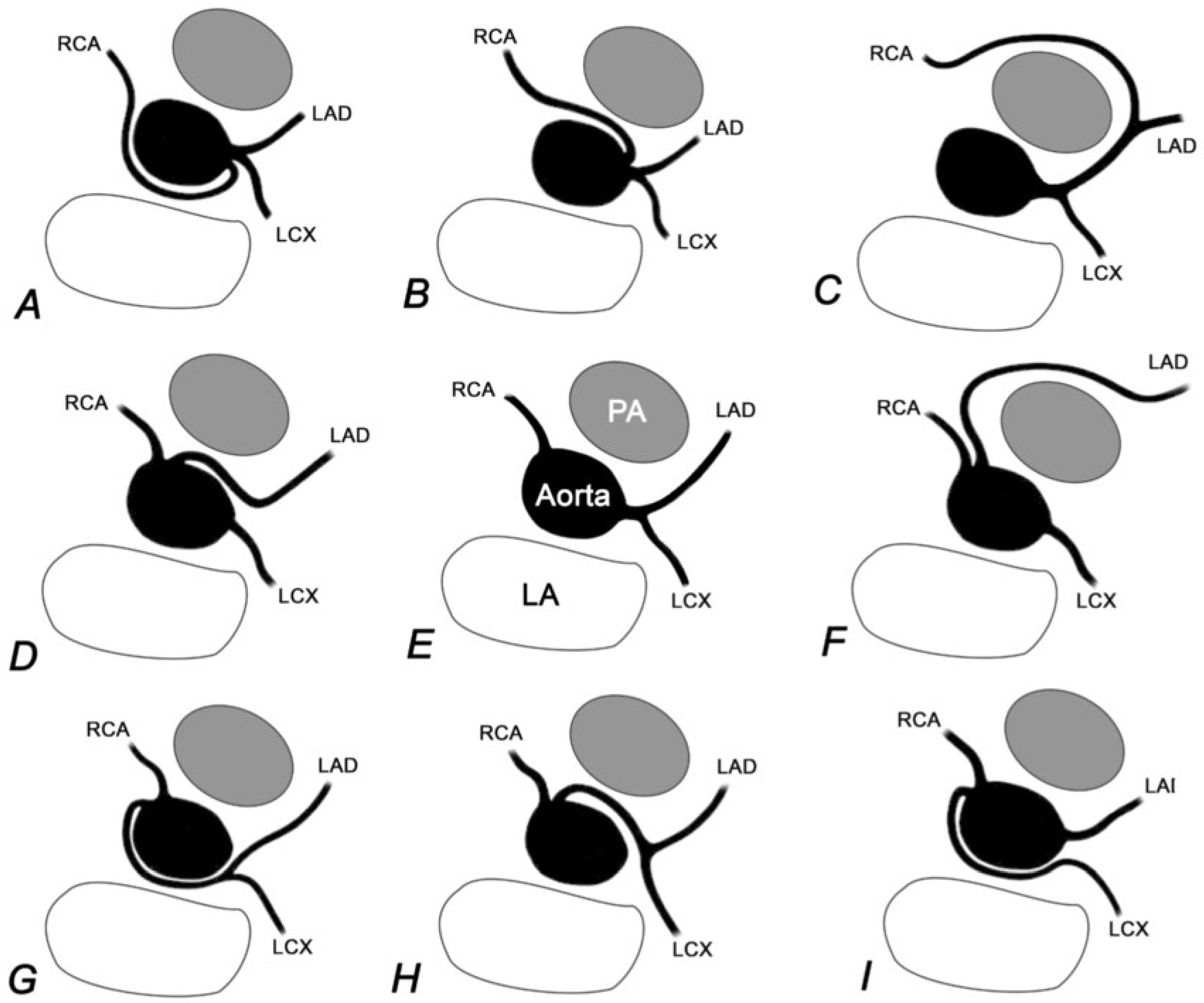
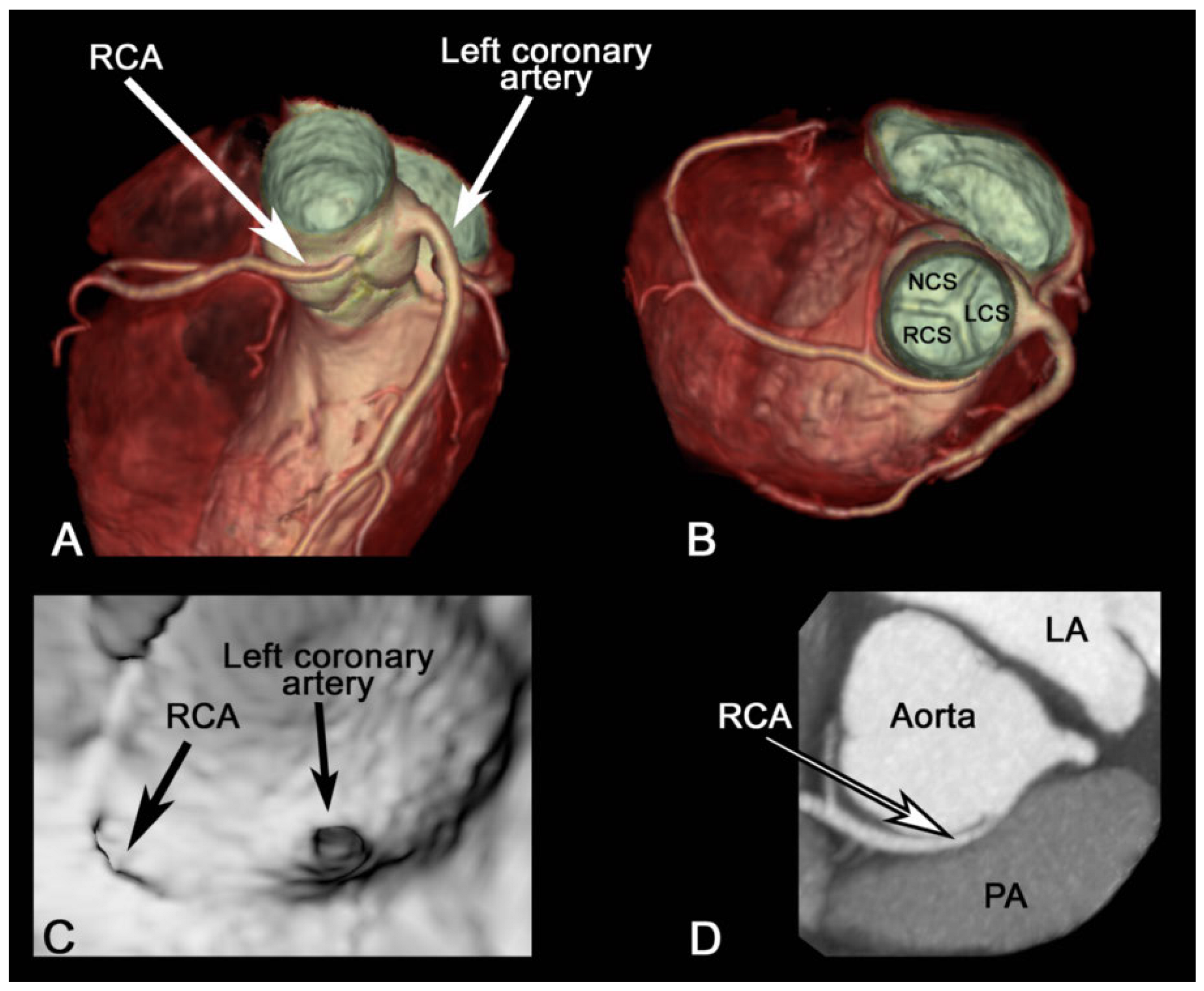
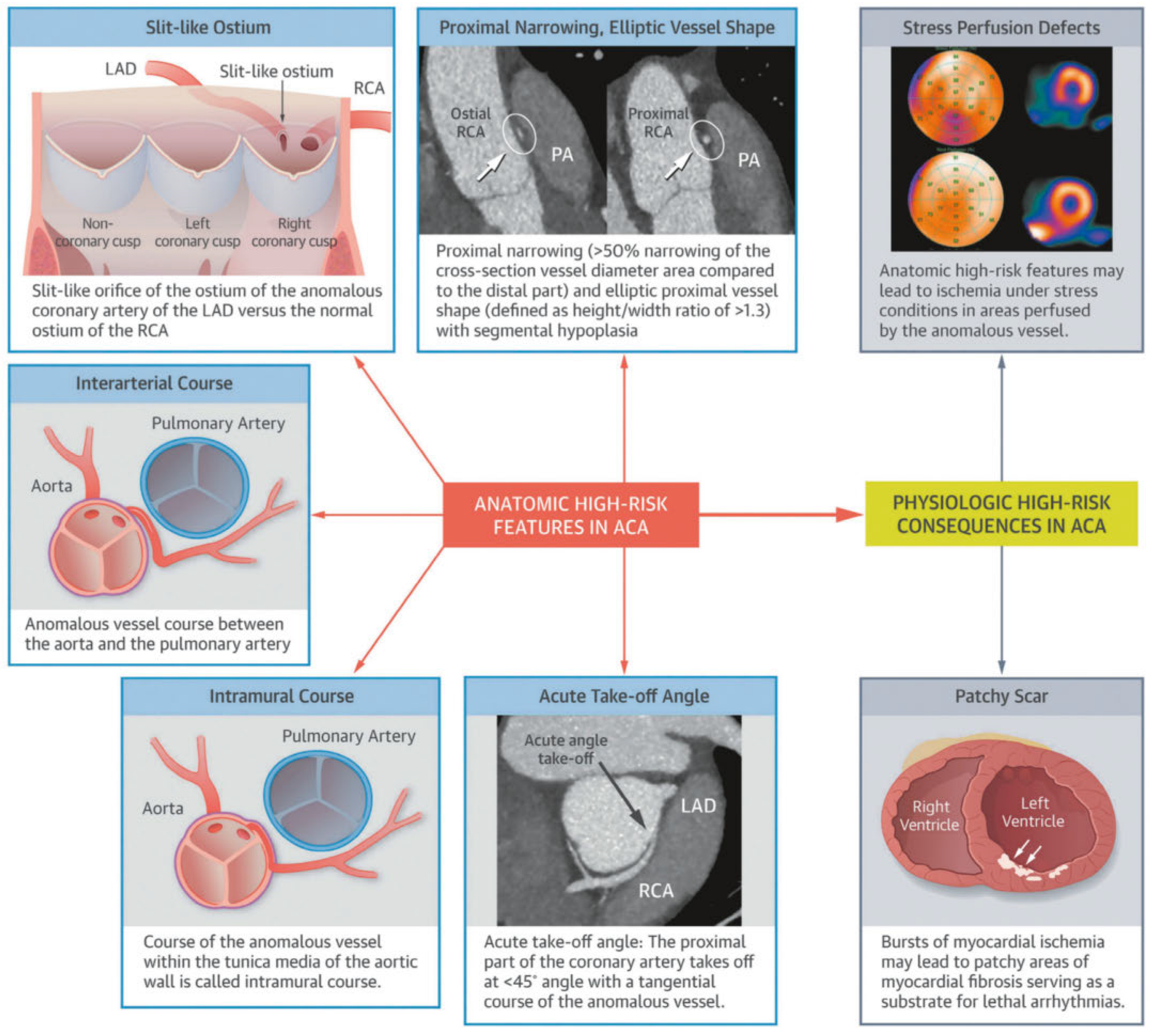
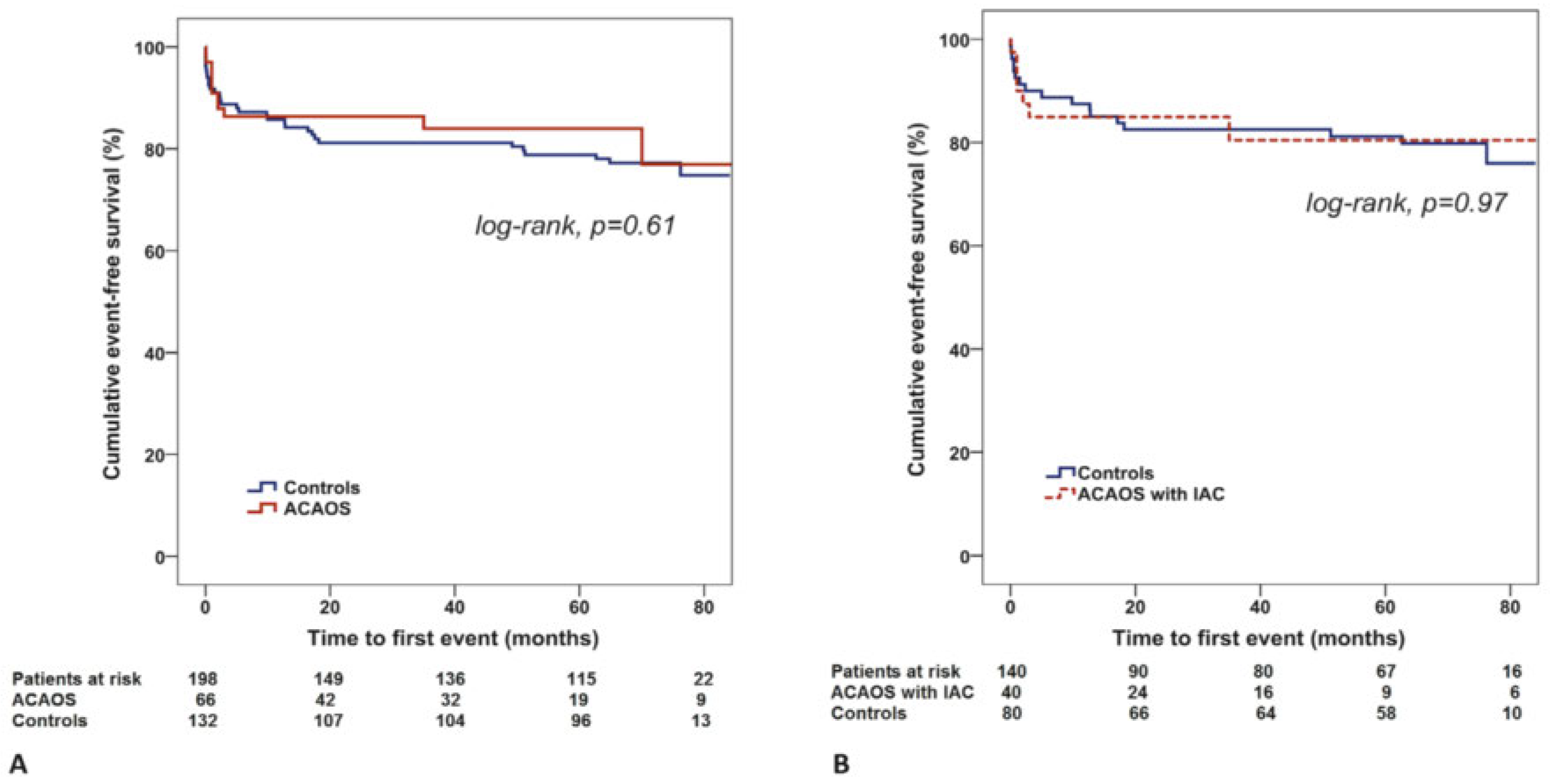
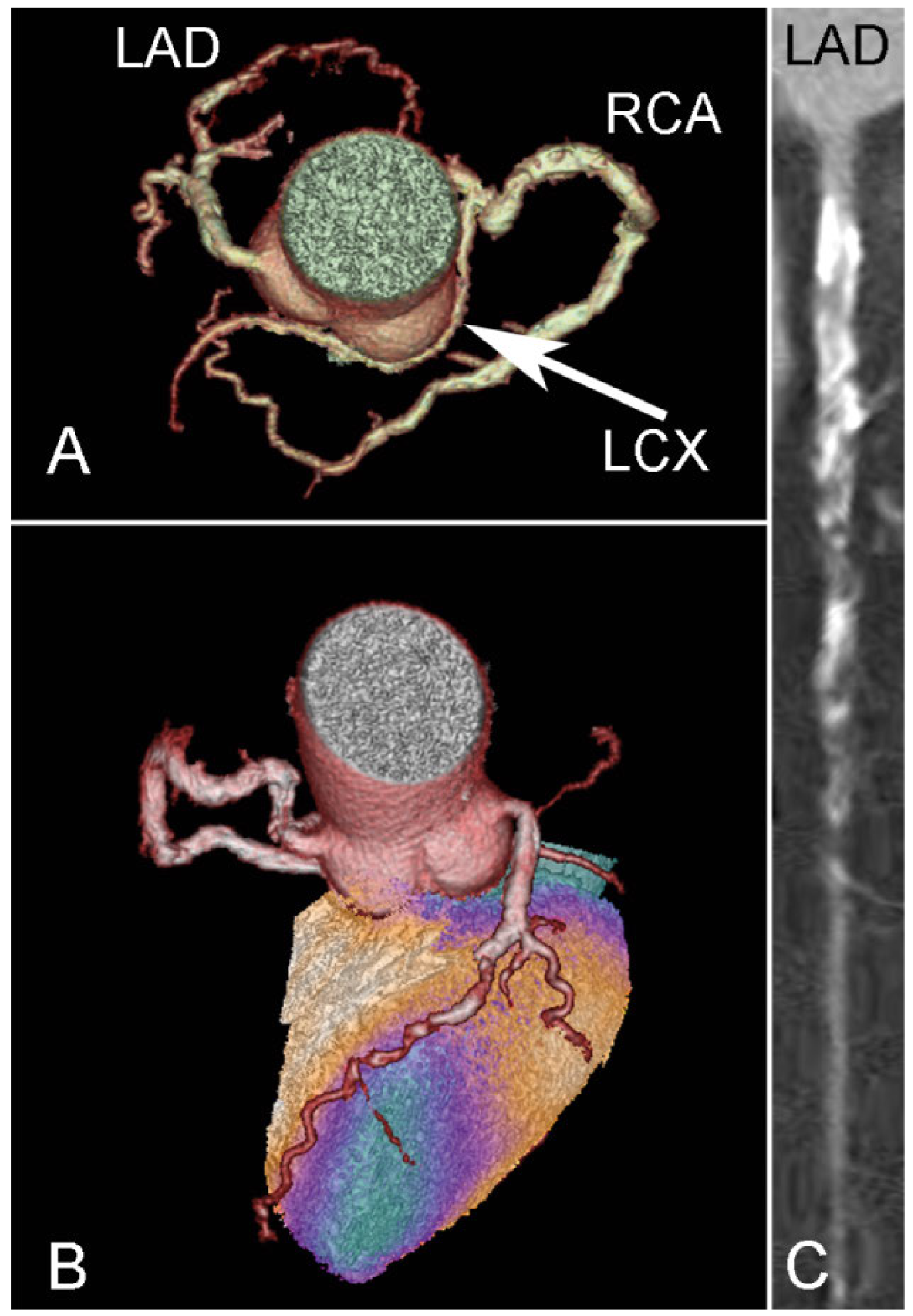
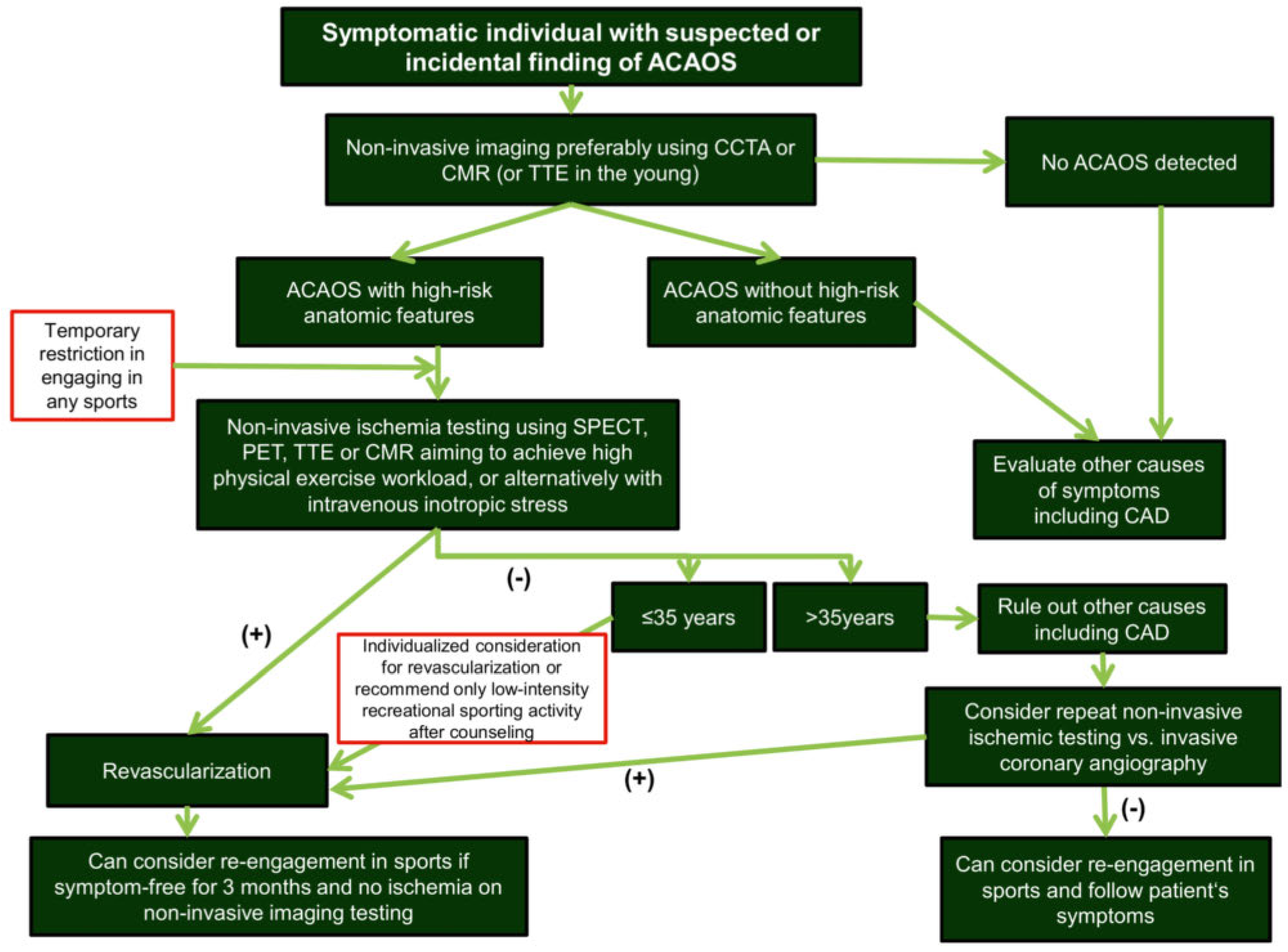
| Classification | Cases | Prevalence (%) | ||
|---|---|---|---|---|
| n | % | |||
| Anomalies of vessel origin and course (n = 107) | Separate ostium for LAD and LCX | 27 | (18.6) | 0.48 |
| Single coronary artery | 7 | 0.12 | ||
| Absent LCX | 2 | (1.4) | 0.04 | |
| Bland-White-Garland syndrome | 1 | (0.7) | 0.02 | |
| High take off LAD | 1 | (0.7) | 0.02 | |
| High take off RCA | 3 | (2.0) | 0.05 | |
| ACAOS | 66 | 1.17 | ||
| ACAOS with interarterial course | 36 | 0.64 | ||
| ACAOS with prepulmonary course | 3 | 0.05 | ||
| ACAOS with retroaortic course | 27 | 0.37 | ||
| LM from noncoronary sinus | 5 | (3.5) | 0.09 | |
| RCA from noncoronary sinus | 1 | (0.7) | 0.02 | |
| Anomalies of intrinsic coronary arterial anatomy (n = 33) | Duplication of LAD | 6 | (4.1) | 0.11 |
| Duplication of RIM | 2 | (1.4) | 0.04 | |
| Duplication of RCA | 1 | (0.7) | 0.02 | |
| Ectasia | 12 | (8.3) | 0.21 | |
| Hypoplasia of LCX | 8 | (5.5) | 0.14 | |
| Hypoplasia of RCA | 4 | (2.8) | 0.07 | |
| Anomalies of vessel termination (n = 5) | Coronary artery fistula | 5 | 0.09 | |
| LAD to pulmonary artery | 3 | (2.1) | 0.05 | |
| LAD and RCA to pulmonary artery | 1 | (0.7) | 0.02 | |
| LCX to Coronary Sinus | 1 | (0.7) | 0.02 | |
| TTE | TEE | CCTA | CMR | Invasive angiography and IVUS | ||
| Spatial resolution | ++ | ++ | +++ | ++ | ++++ | |
| Temporal resolution | ++ | +++ | ++ | ++ | +++ | |
| Anatomy of coronary arteries | Proximal | +++ | +++ | ++++ | ++++ | +++ |
| Distal | + | + | ++++ | ++ | +++ | |
| Anatomical high-risk features in anomalous coronary arteries | Interarterial course | ++ | ++ | ++++ | ++++ | ++ |
| Slit-like ostium | + | + | ++++ | ++ | +++ | |
| Take-off angle | ++ | + | ++++ | ++++ | + | |
| Intramural course | ++ | ++ | ++++ | +++ | ++++ | |
| Proximal narrowing | ++ | ++ | +++ | ++ | +++ | |
| Elliptical shape | ++ | ++ | +++ | ++ | +++ |
© 2018 by the author. Attribution - Non-Commercial - NoDerivatives 4.0.
Share and Cite
Gräni, C. Anomalous Coronary Arteries and the Risk of Adverse Cardiac Events. Cardiovasc. Med. 2018, 21, 39. https://doi.org/10.4414/cvm.2018.00540
Gräni C. Anomalous Coronary Arteries and the Risk of Adverse Cardiac Events. Cardiovascular Medicine. 2018; 21(2):39. https://doi.org/10.4414/cvm.2018.00540
Chicago/Turabian StyleGräni, Christoph. 2018. "Anomalous Coronary Arteries and the Risk of Adverse Cardiac Events" Cardiovascular Medicine 21, no. 2: 39. https://doi.org/10.4414/cvm.2018.00540
APA StyleGräni, C. (2018). Anomalous Coronary Arteries and the Risk of Adverse Cardiac Events. Cardiovascular Medicine, 21(2), 39. https://doi.org/10.4414/cvm.2018.00540




